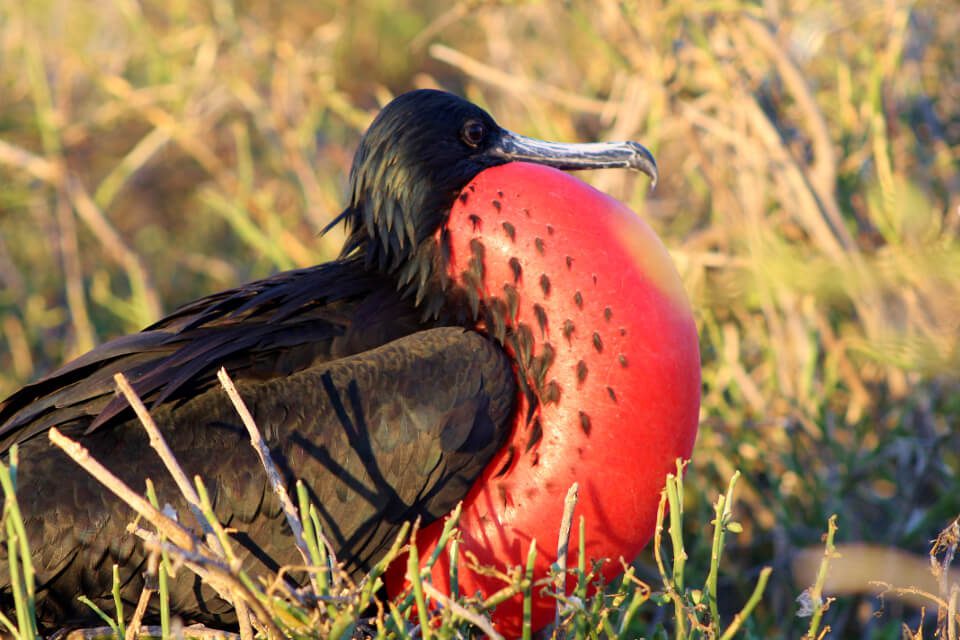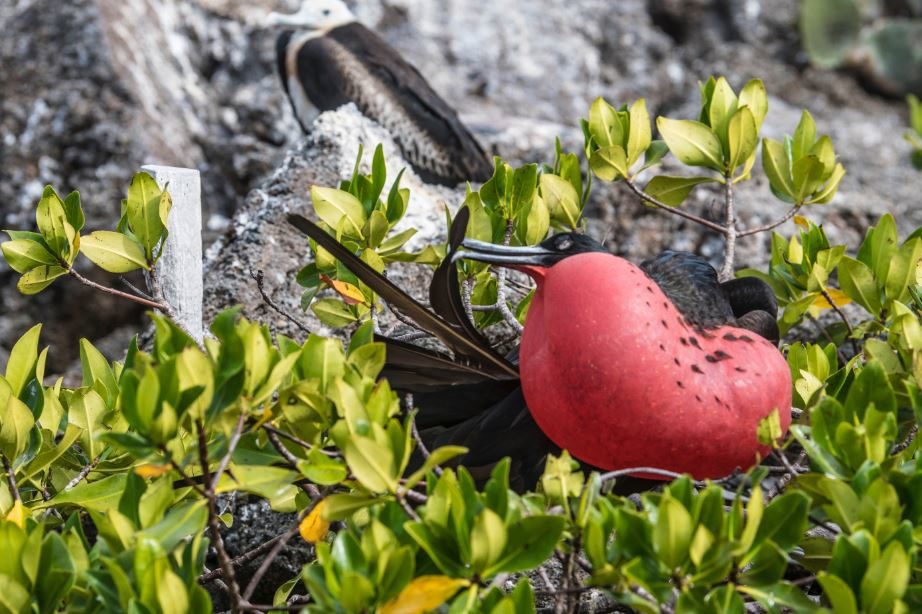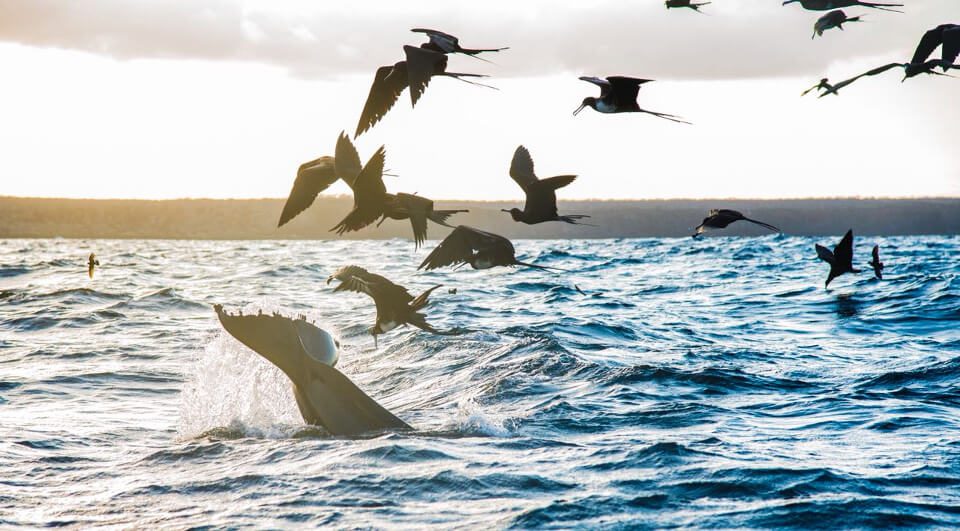As you wade through colonies of blue-footed boobies, magnificent frigatebirds, and swallow-tail gulls on North Seymour Island, watch carefully for the sharp black feathers and bright red chest of the Galapagos Great Frigatebird. The Galapagos Islands are the proud home of some of the greatest wonders of the natural world, but the great frigatebird is certainly near the top of this list. However, it is a rare visitor to the islands, not because it does not prefer these stunning shores to others, but because it spends months at a time in flight, soaring over the vast Pacific Ocean before ever landing on solid ground. From time to time, though, they must come down to nest, and when they do they put one-kind-of-a-show. Best of all, various islands and visitor sites offer a rewarding chance of seeing these wondrous birds in full scope.

Get a close look at the Magnificent and Great frigatebirds of the Galapagos Islands!
Migration study
A team of researchers from France, the U.K., Canada, and Germany recently released a report on the Great Frigatebird, revealing that it can spend up to two months without landing on either the ocean or solid ground. The team attached trackers to several birds as a part of a two-year-long study to better understand its migratory habits. The trackers were able to monitor GPS positioning, heart rate, altitude, and acceleration in all directions, thus allowing them to follow the birds and detect how much energy they were exerting at all times, providing possible answers to how the birds sleep and function without ever touching the ground.
TALK TO A DESTINATION EXPERT

Diego Zapata

Rosa Mena

Sandy Lara

Diego Zapata

Rosa Mena

Sandy Lara
As the team followed the birds throughout their migration, they found that they are much more efficient flyers than what had previously been thought. The birds they were tracking traveled up to 250 miles in just one day, and by positioning themselves within certain updrafts they could soar upwards at up to 5 meters a second. In this way, the Galapagos great frigatebird is able to travel as high as 4,000 meters. Even more impressive is the fact that they are able to travel such impressive distances while barely flapping their wings.

Flight techniques
The Galapagos great frigatebird has several techniques to travel such incredible distances at such remarkable heights without collapsing from exhaustion. Great frigates are keenly aware of wind patterns and are able to track the edges of doldrums, which they take advantage of as a source of momentum to push them along in the air. Once they are appropriately located within one of these thermal columns of air, they only need to move their wings every now and then to better their position within the current. Furthermore, because they are only exerting small amounts of energy to do this, they do not require much food. When they do eat, they merely swoop down to grab a fish jumping out of the water, exerting less energy than other marine bird that dives into the water. Nevertheless, this method is not a technique to conserve energy but is instead necessary for their survival. The interesting birds of the Galapagos produce very little oil to waterproof their wings, thus once their feathers get wet they become water-laden and too heavy to fly, putting the birds in serious danger of drowning. It is rather common to see them performing the most stunning acrobatic maneuvers in mid-air as they try to harass other birds that may disgorge their highly-priced morsels. In order to be this agile, you need to truly be a master of the air.

Another key factor of its harrowing migration is its body, which is magnificently crafted for this very purpose. The bird has an enormous wingspan, reaching up to 230 centimeters in length; however, its body is small and aerodynamic. In fact, the team noted that the Galapagos great frigatebird has the smallest ratio of body weight to wing surface area than any other bird. This ratio makes them excellent gliders, further allowing them to take advantage of the doldrums.
Galapagos Great Frigatebird Hidden secrets
Nevertheless, several mysteries still exist around these birds. One of the greatest is their ability to sleep for several months in the air. The study suggests that the birds are able to take power naps as they are lifted high into the clouds by the doldrums. The team believes that the birds are able to fall into a deep sleep that is just a couple of minutes long; however, this theory has yet to be proven. On the other hand, as they soar through the air thousands of meters above the ground, they face freezing temperatures and extremely thin air. Here, experts are dumbfounded as to how the birds are able to support such extreme temperatures. Their plumage is not particularly thick and was certainly not made for freezing temperatures. As a solution, the birds would have to increase their body temperature, which, according to the study, they do not do.
Although this study has answered several questions, the secret to these birds’ long-distance migration remains a mystery. If you are lucky enough to see one in the Galapagos awkwardly waddling around on its short legs, take a moment to wonder at its mysterious journeys and ultimate power.
Perfect Timing for Red Balloons
There are no special setups for watching and witnessing a nesting colony of frigatebirds while exploring the Galapagos Islands. Magnificent frigatebirds can be seen well in North Seymour Island, while Great frigatebirds can be observed up north in Genovesa Island. Another great spot to see them, at least while exploring the dramatic volcanic coastline, is Punta Pitt at San Cristobal Island. Throughout your Galapagos voyage, you will certainly see them flying and hovering literally everywhere. Their mating season can be seen throughout the year for the Magnificent frigatebird, while the months of the hot season (December-May) tend to be a better time for spotting courting and nesting behavior for Galapagos Great frigatebirds.

Javier Garcia

Eduardo Silva

Carolina Escobar
START PLANNING YOUR TRIP

Javier Garcia

Eduardo Silva

Carolina Escobar
Get in touch for more
CONTACT US
Blog Reviewed & Edited by: Francisco Dousdebés
All Images & Video Footage: Francisco Dousdebés


